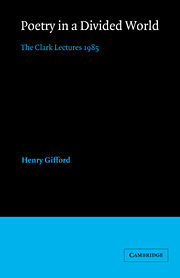3 - Isolation and community
Published online by Cambridge University Press: 19 September 2009
Summary
In 1952 Eugenio Montale spoke at an international congress in Paris, devoted to the already familiar theme of ‘Isolation and Communication’. His paper, entitled ‘The Solitude of the Artist’, came from one particularly at home with the subject. Conditions in Fascist Italy when he published his first book of poetry in 1925 had forced him to become by and large a hermetic writer, though he was also by temperament inclined that way. He seemed to himself in those days like a man living ‘under a glass bell’, yet feeling nonetheless ‘close to something essential’. That sense of separation from others and nearness to a hidden reality was characteristic of Montale, and it determined his line of argument in this paper. ‘No one in our time’, he said, ‘was more isolated than Kafka; and few have achieved communication as well as he did’. Montale used this striking example to support his main contention. ‘The man who communicates’, he believed, ‘is the transcendental I concealed in us that recognises itself in others’.
This is not the moment to pause on what Montale had to say about the communicators – the media experts – whose prominence has grown much more threatening since 1952. He insisted that it is only ‘the great isolated figures’ of an epoch who speak and communicate: ‘their isolation ’, he asserted, ‘is more illusory than real’.
- Type
- Chapter
- Information
- Poetry in a Divided WorldThe Clark Lectures 1985, pp. 50 - 73Publisher: Cambridge University PressPrint publication year: 1986



